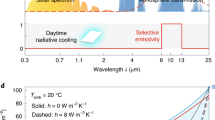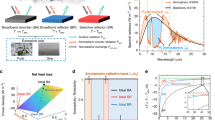Abstract
A natural mechanism is proposed for heating and cooling the surface of the Earth so that all living beings can live in a consistent comfortable temperature condition throughout the seasons. To accomplish this, photon particles are remodeled by implementing the Bose–Einstein (B–E) dormant photonic dynamics of the Earth surface plane. Simply, the proposed decoded B–E photons are induced by the photonic band-gap of the Earth’s surface to convert solar photons into cooling-state photons, here named Hossain cooling photons (HcP−s), which will eventually cool the Earth’s surface. Interestingly, an HcP− can be converted into a thermostate photon, named the Hossain thermal photon (HtP−), by implementing the Higgs boson (H → γγ−) electromagnetic quantum fields utilized by the Earth’s electromagnetic force. The H → γγ− quantum field of the Earth surface plane has an extremely small weak force, which will force the electrically charged HcP− quantum to convert into an HtP− to naturally heat the Earth’s surface. The formation of HcP− particles from the photon particles and then the conversion of HcP− to HtP− are proven by a set of mathematical tests in this research, which reveals the feasibility that the deformed photons (HcP− and HtP−) can actively interact with the Earth’s surface to naturally cool and heat the Earth.


(Source: Matin 2007. Science)

Source: Martin 2007. Science)


(Source: Matin 2007. Science)


(Source: Martin 2007. Science)


(SourceMartin 2007. Science)
Similar content being viewed by others
References
Agger, A. K., & Sørensen, A. H. (1997). Atomic and molecular structure and dynamics. Physical Review A, 55, 402–413.
Arnold, P., Moore, G. D., & Yaffe, L. G. (2001). Photon Emission from Ultrarelativistic Plasmas. Journal of High Energy Physics, 11, 057.
Artemyev, N., Jentschura, U. D., Serbo, V. G., & Surzhykov, A. (2012). Strong electromagnetic field effects in ultra-relativistic heavy-ion collisions. The European Physical Journal B, 72, 1935.
Baur, G., Hencken, K., & Trautmann, D. (2007). Revisiting unitarity corrections for electromagnetic processes in collisions of relativistic nuclei. Physics Reports, 453, 1–27.
Baur, G., Hencken, K., Trautmann, D., Sadovsky, S., & Kharlov, Y. (2002). Dense laser-driven electron sheets as relativistic mirrors for coherent production of brilliant X-ray and γ-ray beams. Physics Reports, 364, 359–450.
Becker, U., Grün, N., & Scheid, W. (1987). K-shell ionisation in relativistic heavy-ion collisions. Journal of Physics B: Atomic and Molecular Physics, 20, 2075.
Belkacem, A., Gould, H., Feinberg, B., Bossingham, R., & Meyerhof, W. E. (1993). Semiclassical dynamics and relaxation. Physical Review Letters, 71, 1514–1517.
Benavides, N. D., & Chapman, P. L. (2008). Modeling the effect of voltage ripple on the power output of photovoltaic modules. IEEE Transactions on Industrial Electronics, 55, 2638–2643.
Boukhezzar, B., & Siguerdidjane, H. (2009). Nonlinear control with wind estimation of a DFIG variable speed wind turbine for power capture optimization. Energy Conversion and Management, 50, 885–892.
Cardoso, V., Lemos, J. P., & Yoshida, S. (2004). Quasinormal modes of Schwarzschild black holes in four and higher dimensions. Physical Review D, 69(4), 044004.
Celik, A. N., & Acikgoz, N. (2007). Modelling and experimental verification of the operating current of mono-crystalline photovoltaic modules using four- and five-parameter models. Applied Energy, 84, 1–15.
Chihhui, W. (2012). Metamaterial-based integrated plasmonic absorber/emitter for solar thermophotovoltaic systems. Journal of Optics.
De Soto, W., Klein, S. A., & Beckman, W. A. (2006). Improvement and validation of a model for photovoltaic array performance. Solar Energy, 80, 78–88.
Douglas, J. S., Habibian, H., Hung, C.-L., Gorshkov, A. V., Kimble, H. J., & Chang, D. E. (2015). Quantum many-body models with cold atoms coupled to photonic crystals. Nature Photonics, 9, 326–331.
Eichler, J., & Stöhlker, T. (2007). Radiative electron capture in relativistic ion-atom collisions and the photoelectric effect in hydrogen-like high-Z systems. Physics Reports, 439, 1–99.
Faida, H., & Saadi, J. (2010). Modelling, control strategy of DFIG in a wind energy system and feasibility study of a wind farm in Morocco. IREMOS, 3, 1350–1362.
Ghennam, T., Berkouk, E. M., & Francois, B. (2007). A vector hysteresis current control applied on three-level inverter. Application to the active and reactive power control of doubly fed induction generator based wind turbine. IREE, 2, 250–259.
Gopal, C., Mohanraj, M., Chandramohan, P., & Chandrasekar, P. (2013). Renewable energy source water pumping systems—a literature review. Renewable Sustainable Energy Reviews, 25, 351–370. https://doi.org/10.1016/j.rser.2013.04.012.
Güçlü, M. C., Li, J., Umar, A. S., Ernst, D. J., & Strayer, M. R. (1999). Electromagnetic lepton pair production in relativistic heavy-ion collisions. Annalen der Physik, 272, 7–48.
Gupta, N., Singh, S. P., Dubey, S. P., & Palwalia, D. K. (2011). Fuzzy logic controlled three-phase three-wired shunt active power filter for power quality improvement. IREE, 6, 1118–1129.
Hossain, M. F. (2016a). Solar energy integration into advanced building design for meeting energy demand. International Journal of Energy Research, 40, 1293–1300.
Hossain, M. F. (2016b). Production of clean energy from cyanobacterial biochemical products. Strategic Planning for Energy and the Environment, 3, 6–23.
Hossain, M. F. (2016c). Theory of global cooling. Energy, Sustainability, and Society, 6, 1–5.
Hossain, M. F. (2017a). Invisible transportation infrastructure technology to mitigate energy and environment. Energy, Sustainability, and Society, 7, 27. https://doi.org/10.1186/s13705-017-0128-x.
Hossain, M. F. (2017b). Application of advanced technology to build a vibrant environment on planet Mars. International Journal of Environmental Science and Technology., 14(12), 2709–2720.
Hossain, M. F. (2017c). Green science: Independent building technology to mitigate energy, environment, and climate change. Renewable and Sustainable Energy Reviews, 73, 695–705.
Hossain, M. F. (2017d). Green science: Advanced building design technology to mitigate energy and environment. Renewable and Sustainable Energy Reviews, 81, 3051–3060.
Hossain, M. F. (2017e). Design and construction of ultra-relativistic collision PV panel and its application into building sector to mitigate total energy demand. Journal of Building Engineering., 9, 147–154.
Hossain, M. F. (2018a). Sustainable design and build. In Monograph (468 p) Elsevier. ISBN: 9780128167229.
Hossain, M. F. (2018b). Green science: Advanced building design technology to mitigate energy and environment. Renewable and Sustainable Energy Reviews, 81(2), 3051–3060.
Hossain, M. F. (2018c). Photonic thermal energy control to naturally cool and heat the building. Applied Thermal Engineering., 131, 576–586.
Hossain, M. F. (2018d). Green science: Decoding dark photon structure to produce clean energy. Energy Reports, 4, 41–48.
Hossain, M. F. (2018e). Photon application in the design of sustainable buildings to console global energy and environment. Applied Thermal Engineering., 141, 579–588.
Hossain, M. F. (2018f). Transformation of dark photon into sustainable energy. International Journal of Energy and Environmental Engineering., 9, 99–110.
Hossain, M. F. (2018g). Global environmental vulnerability and the survival period of all living beings on earth. International Journal of Environmental Science and Technology. https://doi.org/10.1007/s13762-018-1722-y.
Hossain, M. F. (2018h). Photon energy amplification for the design of a micro PV panel. International Journal of Energy Research. https://doi.org/10.1002/er.4118.
Hossain, M. F. (2018i). Bose–Einstein (B–E) photonic energy structure reformation for cooling and heating the premises naturally. Advanced Thermal Engineering., 142, 100–109.
Hossain, M. F., & Fara, N. (2016). Integration of wind into running vehicles to meet its total energy demand. Energy, Ecology, and Environment., 2(1), 35–48.
Huot, S. C., Kovtun, P., Moore, G. D., Starinets, A., & Yaffe, L. G. (2006). Photon and dilepton production in supersymmetric Yang-Mills plasma. Journal of High Energy Physics, 2006(12), 015.
Kamal, E., Koutb, M., Sobaih, A. A., & Abozalam, B. (2010). An intelligent maximum power extraction algorithm for hybrid wind-diesel-storage system. International Journal of Electrical Power & Energy Systems, 32, 170–177.
Laine, M. (2013). Thermal 2-loop master spectral function at finite momentum. Journal of High Energy Physics, 2013, 83.
Langer, L., Poltavtsev, S. V., Yugova, I. A., Salewski, M., Yakovlev, D. R., Karczewski, G., et al. (2014). Access to long-term optical memories using photon echoes retrieved from semiconductor spins. Nature Photonics, 8, 851–857.
Li, Q., Xu, D. Z., Cai, C. Y., & Sun, C. P. (2013). Recoil effects of a motional scatterer on single-photon scattering in one dimension. Scientific Reports, 3(1), 1–6.
Lo, P. Y., Xiong, H. N., & Zhang, W. M. (2015). Breakdown of Bose–Einstein distribution in photonic crystals. Scientific reports, 5, 9423.
Martin, F. (2007). Single photon-induced symmetry breaking of H2 dissociation. Science, 325, 629–633.
Najjari, B., Voitkiv, A. B., Artemyev, A., & Surzhykov, A. (2009). Simultaneous electron capture and bound-free pair production in relativistic collisions of heavy nuclei with atoms. Physical Review A, 80, 012701.
Park, J., Kim, H., Cho, Y., & Shin, C. (2014). Simple modeling and simulation of photovoltaic panels using matlab/simulink. Advanced Science and Technology Letters, 73, 147–155.
Pregnolato, T., Lee, E. H., Song, J. D., Stobbe, S., & Lodahl, P. (2015). Single-photon non-linear optics with a quantum dot in a waveguide. Nature Communications, 6, 8655.
Reinhard, A., Volz, T., Winger, M., Badolato, A., Hennessy, K. J., Hu, E. L., et al. (2012). Strongly correlated photons on a chip. Nature Photonics, 6, 93–96.
Robyns, B., Francois, B., Degobert, P., & Hautier, J. P. (2012). Vector control of induction machines. London: Springer.
Sharma, K. G., Bhargava, A., & Gajrani, K. (2013). Stability analysis of DFIG based wind turbines connected to electric grid. IREMOS, 6, 879–887.
Sivasankar, G., & Kumar, V. S. (2013). Improving low voltage ride through of wind generators using STATCOM under symmetric and asymmetric fault conditions. IREMOS, 6, 1212–1218.
Soedibyo, A., Pamuji, F. A., & Ashari, M. (2013). Grid quality hybrid power system control of microhydro, wind turbine and fuel cell using fuzzy logic. IREMOS, 6, 1271–1278.
Soon, J. J., Low, K. S. (2012). Optimizing photovoltaic model parameters for simulation. In IEEE international symposium on industrial electronics (pp. 1813–1818).
Szafron, R., & Czarnecki, A. (2016). High-energy electrons from the muon decay in orbit: Radiative corrections. Physics Letters B, 753, 61–64.
Tame, M. S., McEnery, K. R., Özdemir, Ş. K., Lee, J., Maier, S. A., & Kim, M. S. (2013). Quantum plasmonics. Nature Physics, 9(6), 329–340.
Tan, Y. T., Kirschen, D. S., & Jenkins, N. (2004). A model of PV generation suitable for stability analysis. IEEE Transactions on Energy Conversion, 19, 748–755.
Tu, M. W. Y., & Zhang, W. M. (2008). Non-Markovian decoherence theory for a double-dot charge qubit. Physical Review B, 78, 235311.
Wang, G., Zhao, K., Shi, J., Chen, W., Zhang, H., Yang, X., et al. (2017). An iterative approach for modeling photovoltaic modules without implicit equations. Applied Energy, 202, 189–198.
Xiao, W., Dunford, W. G., Capal, A. (2004). A novel modeling method for photovoltaic cells. In 35th Annual IEEE power electronics specialists conference, Aachen, Germany (pp. 1950––1956).
Xiao, Y. F., Li, M., Liu, Y. C., Li, Y., Sun, X., & Gong, Q. (2010). Asymmetric Fano resonance analysis in indirectly coupled microresonators. Physical Review A, 82, 065804.
Yan, W. B., & Fan, H. (2014). Single-photon quantum router with multiple output ports. Scientific Reports, 4, 4820.
Yang, L., Wang, S., Zeng, Q., Zhang, Z., Pei, T., Li, Y., et al. (2011). Efficient photovoltage multiplication in carbon nanotubes. Nature Photonics, 5, 672–676.
Zhu, Y., Hu, X., Yang, H., & Gong, Q. (2014). On-chip plasmon-induced transparency based on plasmonic coupled nanocavities. Scientific Reports., 4, 3752.
Author information
Authors and Affiliations
Corresponding author
Additional information
Publisher's Note
Springer Nature remains neutral with regard to jurisdictional claims in published maps and institutional affiliations.
Rights and permissions
About this article
Cite this article
Hossain, M.F. Modeling of global temperature control. Environ Dev Sustain 23, 7432–7453 (2021). https://doi.org/10.1007/s10668-020-00924-6
Received:
Accepted:
Published:
Issue Date:
DOI: https://doi.org/10.1007/s10668-020-00924-6




